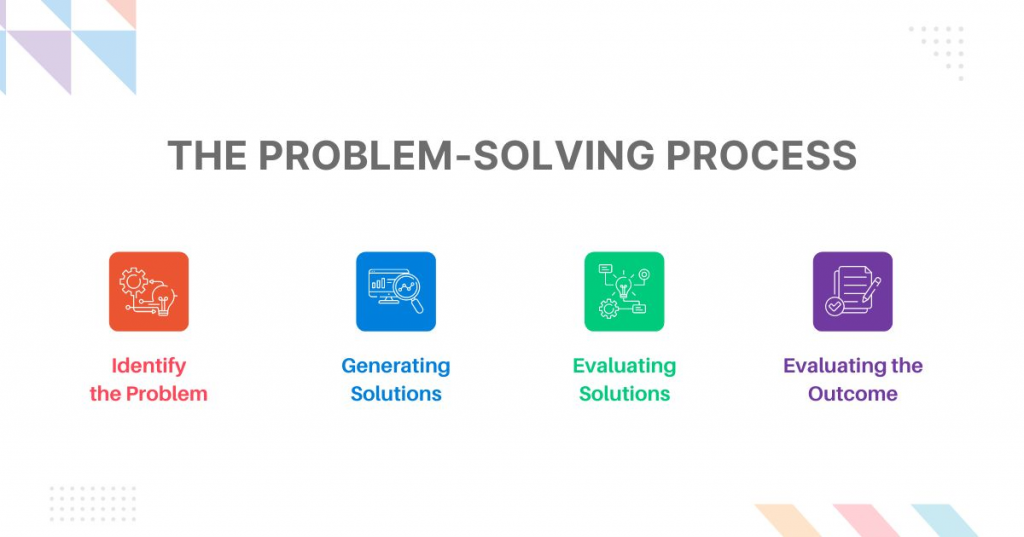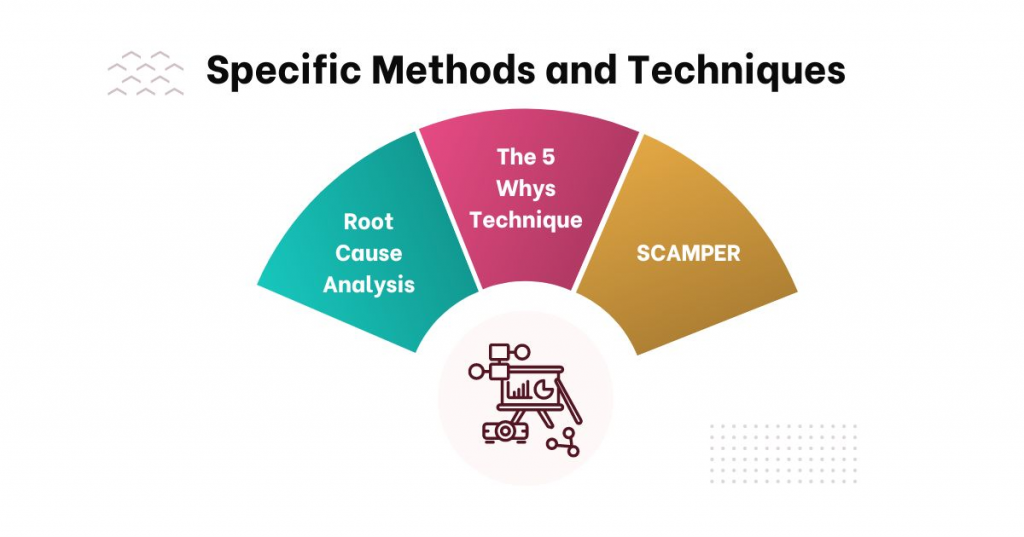Problem Solving Skill: Strategies, Methods, and Techniques
Problem-solving is an important soft skill. It helps us deal with challenges, get past obstacles, and find good solutions in different parts of life. It's like using our brain power in different ways, such as thinking hard, analyzing stuff, being creative, and making decisions.
In this article, we will discuss problem-solving skills, why it are important, and strategies, methods, and techniques to apply this soft skill.
Keep reading!
The Problem-Solving Process

Research by Stress.org show "80% of workers feel stress on the job, nearly half say they need help in learning how to manage stress and 42% say their coworkers need such help."
Mastering a strong problem-solving process can be a game-changer, not just at work but in all aspects of life. This section will guide you through the problem-solving process, equipping you with the tools to tackle any challenge with confidence and find effective solutions.
To solve a problem effectively, we need to identify the problem and plan each step to solve it, and after applying the steps, it takes time to measure to see if the problem is resolved. Is it really resolved?
To go into more detail, effective problem-solving often follows a structured approach, breaking down the complex into manageable steps:
Identifying the Problem: Defining the issue clearly is crucial, as it sets the stage for the entire process. Gathering information and considering different perspectives helps ensure a comprehensive understanding and prevents addressing symptoms instead of the root cause.
Generating Solutions: Encouraging creative brainstorming and exploring diverse approaches allows for the generation of innovative solutions. This stage is about quantity and exploring all possibilities, even seemingly unconventional ones.
Evaluating Solutions: Scrutinizing each potential solution objectively is vital. Considering feasibility, effectiveness, potential risks and benefits, and alignment with goals helps make informed decisions and choose the best option.
Implementing the Chosen Solution: Putting the chosen solution into action requires clear communication of the plan and delegation of tasks if necessary. Effective implementation ensures the solution reaches its full potential.
Evaluating the Outcome: Monitoring the results and assessing the effectiveness of the implemented solution is crucial. This allows for adjustments to be made if needed and ensures the problem is truly addressed.
Although these steps are not applicable to most problems, you can rely on them to handle many simple problems. With complex problems, we will need to break down big problems into small problems and handle each problem one by one.
And so, we have understood the basic process of problem solving, but what about the strategy and things to keep in mind during the problem solving process? Let's find out now!
Strategies for Effective Problem-Solving
"The only true problem is fear itself." Adrian Rogers
This quote by Adrian Rogers captures the essence of why effective problem-solving is so crucial. Many problems shrink or vanish altogether when we approach them with a clear head and a strategic plan.
In this section, we'll explore a range of strategies to equip you to tackle any challenge that comes your way.
Here are some key strategies to enhance your problem-solving skills:
Maintaining a Positive Attitude: A "can-do" attitude fuels persistence and resilience, allowing you to stay motivated even when faced with setbacks. This positive outlook also encourages creative thinking and fosters a collaborative environment when working with others.
Embracing Systematic Thinking: Following a structured approach ensures you don't overlook crucial steps and helps you stay organized throughout the problem-solving process. This can be especially helpful for complex problems with multiple factors to consider.
Gathering Information: Seeking diverse perspectives broadens your understanding and helps you identify potential blind spots in your own thinking. This can involve consulting experts, collaborating with others, and actively seeking information from different sources.
Thinking Creatively: Don't be afraid to step outside the box and explore unconventional solutions. Challenging assumptions and questioning traditional approaches can lead to innovative breakthroughs. Techniques like brainstorming and mind mapping can be helpful for fostering creative thinking.
Practicing Effective Communication: Clear and concise communication is essential for both conveying your ideas effectively and ensuring everyone involved is on the same page. This includes actively listening to others' perspectives, explaining your reasoning, and being open to feedback.
Through incorporating these important strategies and consistently practicing them, you can significantly improve your problem-solving skills and become a more effective problem solver in any situation.
Note that depending on the situation, we will have our own notes when solving the problem. The important thing is to look at the problem from many directions and choose the most suitable method corresponding to the goals we pursue.
Specific Methods and Techniques

Processes and strategies alone are not enough; we need to apply methods and techniques to problem solving to get a clearer picture.
Several methods and techniques can be employed within the problem-solving process, depending on the specific nature of the problem:
Root Cause Analysis: Identify the underlying cause of a problem, addressing it directly to prevent future occurrences.
It sounds a bit simple, but this is the simplest and most effective method when encountering problems. Identify the root cause and find out what factors are needed to solve the problem; don't forget to apply the process we talked about above.
The 5 Whys Technique: Ask "why" five times to delve deeper into the root cause of a problem. It's important to note that this technique may not always lead to the root cause in five steps.
It can still be a valuable tool to get deeper into the problem, but sometimes additional investigation or analysis is necessary.
SCAMPER: This brainstorming technique prompts you to Substitute, Combine, Adapt, Modify, Put to another use, Eliminate, and Rearrange elements of the problem or existing solutions.
This brainstorming technique can be used not only to solve problems but also to generate creative ideas in various fields.
Mind Mapping: Visually represent the problem, its potential solutions, and their interconnectedness using a mind map. This visual approach is not only helpful for understanding the problem but also for fostering collaboration and communication when working with others on a solution.
In short, mind mapping is a powerful tool for problem-solving as it helps you visualize, organize, and brainstorm ideas in a non-linear way. You can use visuals like images, icons, and colors to enhance engagement and memory recall.
By understanding the problem-solving process, employing effective strategies, and utilizing relevant methods and techniques, you can significantly enhance your ability to tackle challenges and find successful solutions in various settings.
Keep exploring and learning different methods and techniques to become an even more effective problem solver!
Skilltrans introduces you to expert-led courses designed to expand your problem-solving skills. Please click on the course name below to learn more:
Soft skills for life & work: develop yourself for success
This course is a practical action oriented course designed to give you the tools, tips and strategies to develop your soft skills for personal development and success in your life and at work, with over 100 practical tips & strategies.
This course aims to give you an insight into the essential soft skills and how you can use these, as well as to look at your own soft skills and identify the areas where you want to improve. The course will also give you a wealth of soft skills tools, tips and strategies to use for personal development and success in your life and at work.
Make the best decisions for your career development
You need to take an important step in your working life, but you don't know where to start.
Maybe you have finished your university or postgraduate studies, you have already got your first job, and suddenly you have a lot of doubts that you had never thought about before.
Or maybe you've been working in the same company for a few years, and you think you're stagnating, and you want to explore new possibilities.
Or you simply want to change your professional direction because you feel that you can do something different that will make you happier, or that will give more meaning to your life.
If you are looking for answers to many questions that you are currently asking yourself professionally, this course can help you to make the professional changes you are looking for.
Final Thoughts
Good problem-solving will help you handle difficult situations, adapt to changes, and do well in a fast-paced world. If you continue to practice and improve, you will get better at solving problems. You can use the materials we have provided to practice problem-solving skills or take an online course on soft skills. Wish you success!



